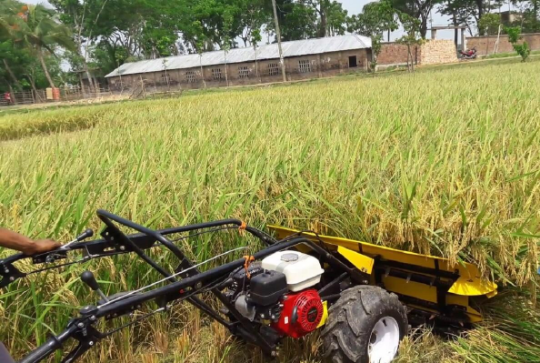Agricultural Machinery: Where is Bangladesh Heading?
Nazia Azrumir Prima | 02 May 2021
The population of Bangladesh is currently 16.8 crore, increasing at the rate of 20 lakh per annum while the cropland is decreasing at the rate of 1 percent per annum. In this situation, the existing agricultural land in the country is creating demand for additional crop production. The number of animal energy is also decreasing due to various reasons including natural disasters. On the other hand, agricultural workers are joining other professions and the labour crisis is on the rise. Due to the increase in demand and insufficiency of labour in the busy season, the farmers become helpless in cutting and threshing. The high labour costs and labour crisis are having a negative impact on agriculture. We do not have the alternative of converting traditional agriculture to modern agriculture to improve this situation. Now, more than 90 percent of the cultivation and irrigation of land are mechanised but sowing and cutting are still lagging behind.
The Food and Agriculture Organization (FAO) of the United Nations (UN) warned Bangladesh about the rising food prices; they also declared that Bangladesh is one of the nine countries with such a price hike. In their report, they showed that the price of rice and other staple food has risen by 35 percent in the past years. To solve this problem there are no alternatives other than minimising the production cost and increasing crop production. If we increase the use of machinery in land cultivation, planting of seeds, weeding, irrigation, fertiliser application, cutting, threshing, cleaning, milling, drying, and transportations, the cost of production will be reduced. Crop production through manual labor is a waste of time, labour, and money. Post-harvest waste in the country is currently 14 percent, which can be reduced with the use of machinery.
The availability of labour in agriculture was 40.20 percent in 2018-19; it is declining day by day. Experts estimate that by 2030, it will be reduced to 30 percent. Because of the rising schooling rates, rapid urbanisation, and mechanical advancement, people don’t want to work as hard as agricultural labourers. Outside, they can perform easier jobs than toiling in the fields. There is no alternative to mechanisation in order to solve the current labour crisis in agriculture. But the overall development in mechanised agriculture is still relatively low. The only agricultural technology implementation centre in Bangladesh located at Bagherpara in Khulna does not have enough initiative to reform. Although modern agricultural machinery factories have been established in other countries of the world, there is no such large factory in our country. If gears, nuts, belts, and pulleys can be made locally in Bangladesh then jobs will be created and equipment will be repaired in the future at lower costs. The amount of subsidy on agricultural machinery should be increased.
About 70,56,000 different types of agricultural machineries are being used in our country at present which include combined harvesters, reapers, rice transplanters, disc harrows, threshers, tractors, power tillers, etc. All these equipment are imported and hence are quite expensive for the small farmers of our country. Farmers can purchase co-operative based agricultural machinery. Farmer’s need to be given proper training about these instruments. Special attention should be paid to the after-sales services of the equipment which are being imported from abroad. The benefits of the 591 technologies that have been developed by the Bangladesh Agricultural Research Council (BARC) in the last ten years should be taken into consideration so that they reach the farmer.
We should be more careful about the shortage of labour during the planting and harvesting season. There are many cases where a lot of farmers who used to live in villages working in the fields, have now started moving to various cities pulling auto-rickshaw or carrying out other jobs. Conventional techniques for crop production should be changed. In most cases, farmers are using traditional methods of sowing and cutting. Due to the bold steps of the Minister of Agriculture, Dr. Md. Abdur Razzak, it has now become possible to acquire labourers from different regions of the haor region. A combined harvester can be utilized to cut and sift the whole paddy and convey it to the farmers’ house. The government has taken up a project called “Mechanisation of agriculture through integrated Management” worth BDT 3,020 crore through Department of Agricultural Extension (DAE) and the project will be implemented in July 2020-2025.
We need to take a course of action for the production of agricultural machinery in our country so that the price will be affordable and new employment will be created. Innovation and new discoveries should be such that it can be easily used by small and medium farmers. Young people can play a vital role in transforming the current traditional agriculture into commercial agriculture. The research students in different universities and research institutions should put more emphasis on developing agricultural machinery. For mechanised agriculture, the government should increase the amount of subsidy on agricultural machinery.
Nazia Azrumir Prima, Program Assistant, Centre for Governance (CGS).
Views in this article are author’s own and do not necessarily reflect CGS policy.
